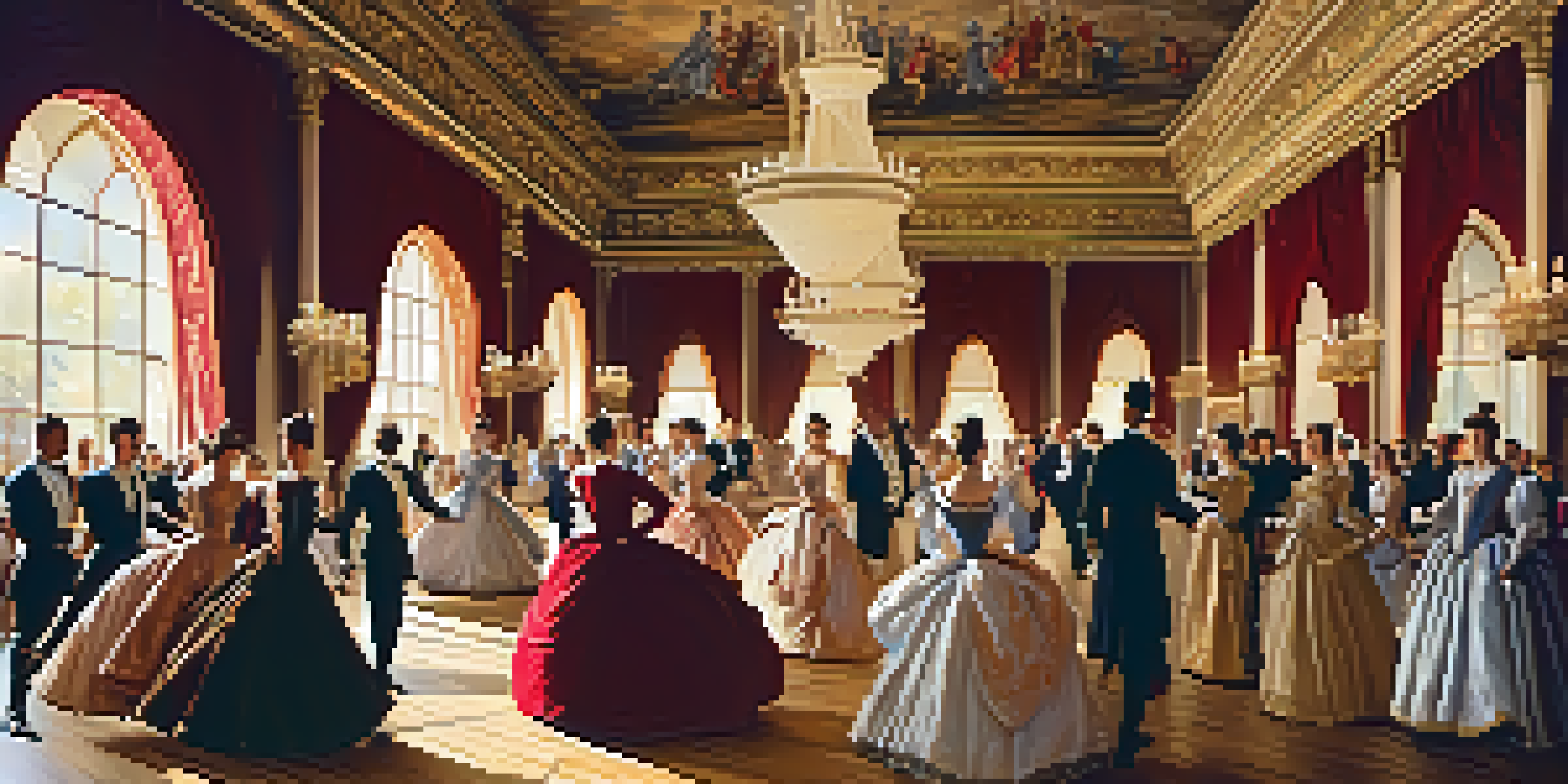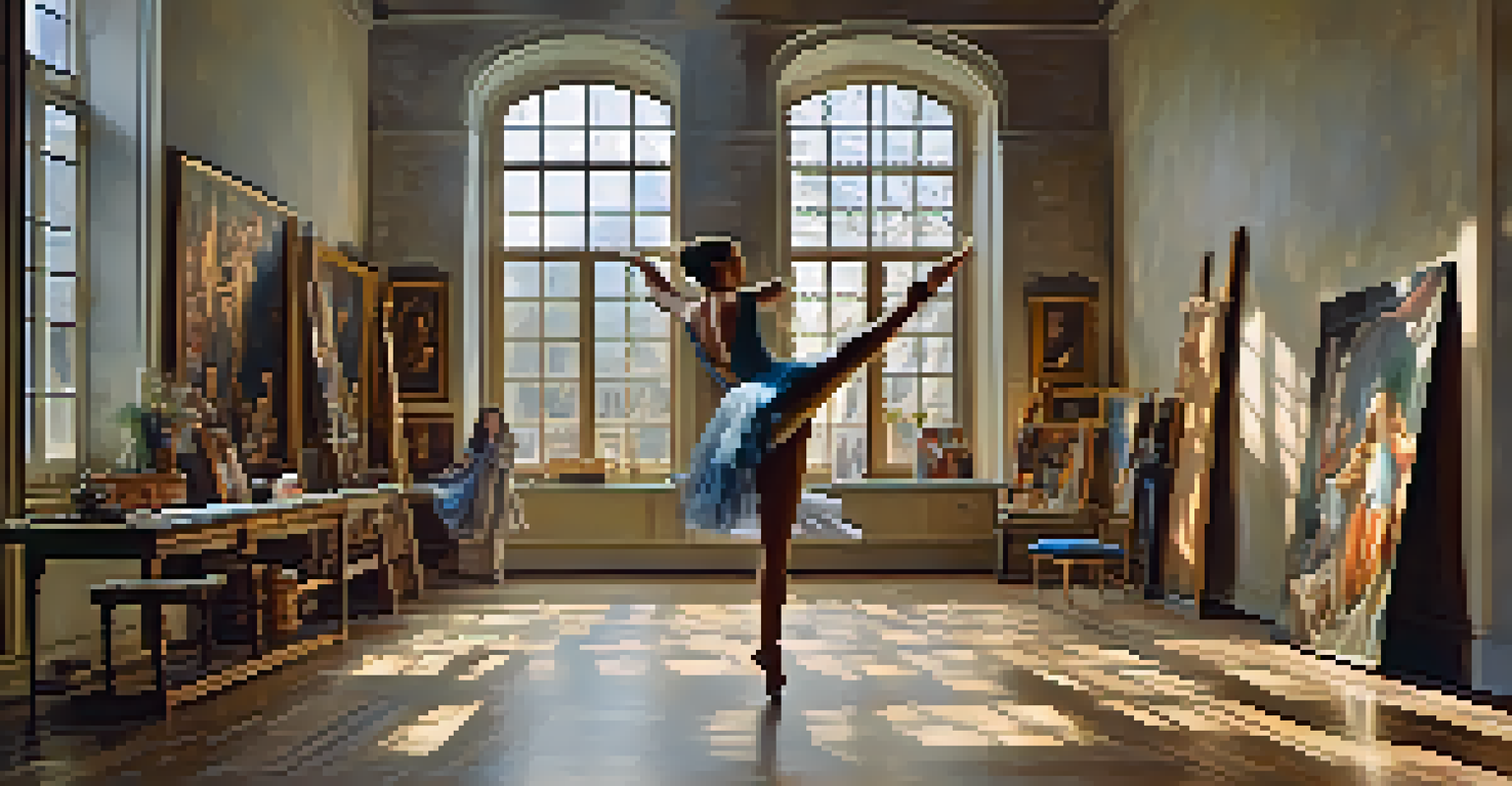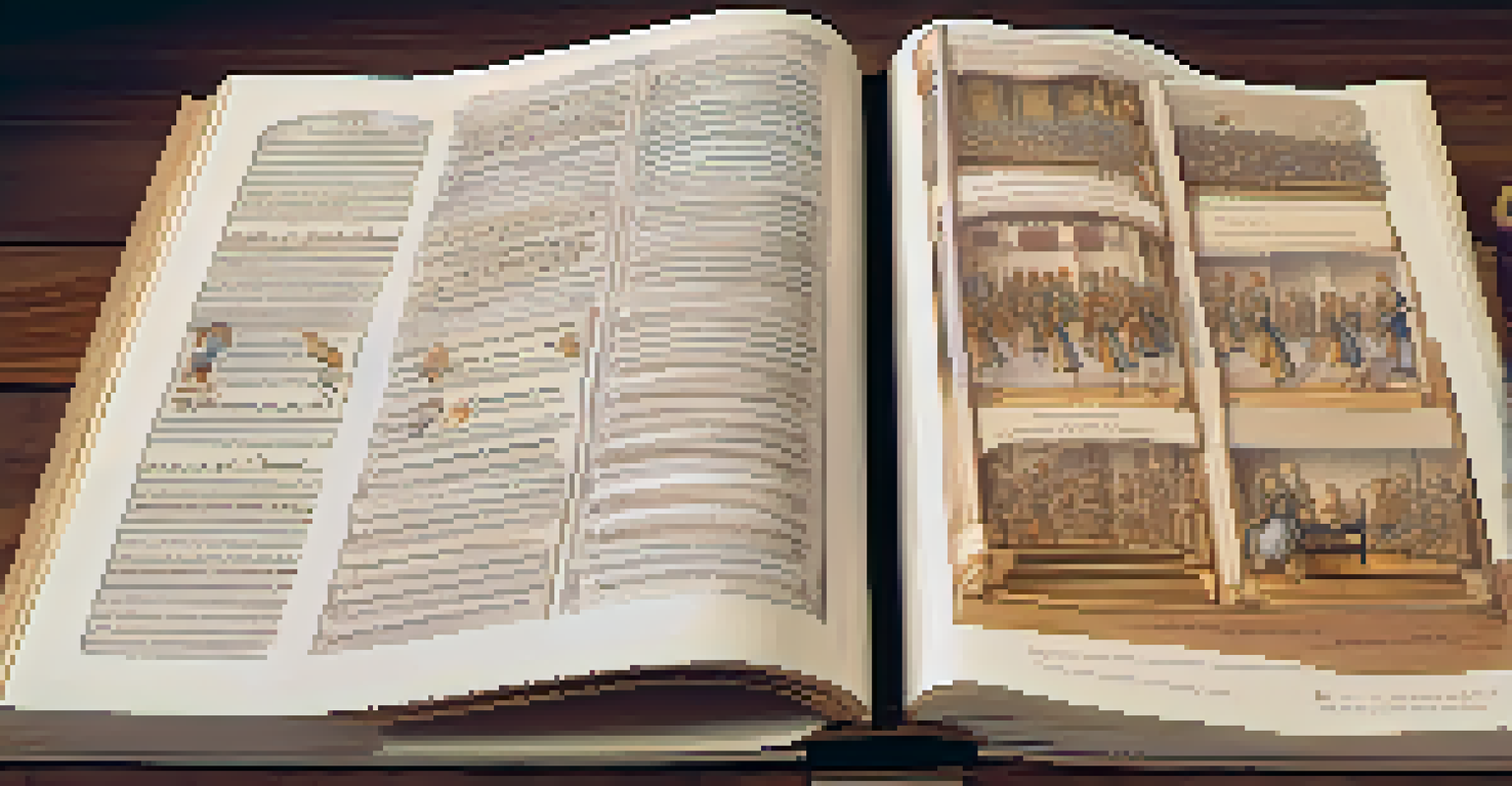The Role of Dance in the Renaissance: Artistic Expression Reimagined

The Birth of Dance as an Art Form in the Renaissance
During the Renaissance, dance emerged as a vital form of artistic expression, intertwining with music and visual arts. It was a period where creativity flourished, and dance was no longer merely a form of entertainment but a sophisticated art form. The revival of classical ideas inspired artists to incorporate movement into their work, showcasing the human body and its capabilities in new ways.
Dance is the hidden language of the soul.
Dance became a means to express emotions and tell stories, much like painting and sculpture. With the influence of the Italian courts, dance characteristics evolved, leading to the development of new styles such as the ballet. This evolution not only enriched the performing arts but also affected how other art forms were perceived and created.
As dance gained prominence, it encouraged artists to explore themes of beauty, grace, and the human experience. This cultural shift laid the groundwork for future artistic movements, illustrating the integral role dance played in shaping Renaissance art.
Influence of Courtly Dance on Renaissance Culture
Courtly dance during the Renaissance was a cornerstone of social gatherings, reflecting the values and aesthetics of the time. Nobility and royalty often commissioned choreographers to create elaborate dance sequences for celebrations, which in turn promoted a culture of elegance and sophistication. The dances were not just physical movements; they were a display of social status and cultural refinement.

These courtly dances also served to strengthen alliances and relationships among powerful families. Events featuring dance allowed for mingling and networking, making it an essential element of Renaissance diplomacy. As a result, the choreography and music developed during this time often carried deeper meanings beyond mere entertainment.
Dance as a Renaissance Art Form
During the Renaissance, dance evolved from mere entertainment to a sophisticated form of artistic expression, reflecting broader cultural themes.
Moreover, this focus on dance influenced other artistic expressions, such as poetry and visual art. Artists began to incorporate themes of movement and rhythm into their works, mirroring the dynamics found in dance. This created a synergy between various art forms, enriching the cultural landscape of the Renaissance.
Dance Manuals: Preserving Renaissance Choreography
As dance flourished, the need for preservation and teaching became apparent, leading to the creation of dance manuals. These instructional books documented various dance styles, steps, and techniques, making dance accessible to a wider audience. Notable figures like Thoinot Arbeau and Giovanni Battista di Vignola authored these manuals, ensuring that the art of dance would not be lost to time.
The dance is a poem of which each movement is a word.
Dance manuals served as a bridge between the elite and the common folk, allowing people from different social classes to engage with this art form. They included illustrations and detailed descriptions, making it easier for readers to learn and practice the dances. This democratization of dance contributed to its popularity and evolution during the Renaissance.
Through these manuals, we gain invaluable insights into the dance culture of the time. They reveal not only the choreography but also the social customs and values of the Renaissance, highlighting how dance was a reflection of society as a whole.
Dance and Its Relationship with Music in the Renaissance
Music and dance have always shared a close relationship, and during the Renaissance, this bond became particularly evident. Composers began to write music specifically for dance, creating distinct styles that matched the rhythms and movements of various dances. This collaboration enhanced the overall experience of performance, drawing audiences into a world where sound and movement harmoniously intertwined.
The use of instruments also evolved, with the introduction of new musical forms that complemented dance. String instruments, woodwinds, and percussion were commonly used to create lively and engaging compositions. As a result, dance music became a genre in its own right, influencing both performance and compositional practices.
Courtly Dance and Social Status
Courtly dance not only showcased elegance but also served as a tool for diplomacy and strengthening familial alliances among the nobility.
This synergy between dance and music not only enriched the cultural offerings of the time but also paved the way for future artistic developments. The interplay between these two forms of expression encouraged artists to experiment with rhythm, tempo, and style, ultimately leading to the diverse array of art we see today.
Theatrical Dance and Its Rise During the Renaissance
The Renaissance saw the rise of theatrical dance, where movement and performance became essential components of storytelling. This merging of dance and theater brought forth new forms of entertainment, including opera and ballet, which captivated audiences with their dramatic flair. Theatrical dance allowed artists to explore complex narratives and emotions, elevating dance to a form of high art.
Notable figures like Michelangelo and Leonardo da Vinci were among those who recognized the importance of human movement in storytelling. Their works often depicted dynamic poses and gestures, emphasizing the narrative quality of dance. This artistic focus encouraged choreographers to develop more intricate and expressive movements that conveyed deeper meanings.
As theatrical dance gained popularity, it also influenced other art forms, including painting and literature. The emphasis on storytelling through movement inspired artists to create works that integrated multiple forms of artistic expression, highlighting the Renaissance's commitment to innovation and creativity.
Symbolism and Themes in Renaissance Dance
Renaissance dance was rich with symbolism, often reflecting the cultural, political, and philosophical ideals of the time. Many dances were imbued with meanings that resonated with the audience, allowing for a deeper connection between performer and spectator. Themes such as love, nature, and the human condition were commonly explored through movement, showcasing the dance's role as a medium for artistic expression.
Choreographers often drew inspiration from classical mythology and literature, weaving these elements into their dances. This blending of influences enriched the storytelling aspect of dance, providing layers of interpretation for those who engaged with the art form. Audiences were invited to reflect on the deeper meanings behind the movements, making dance a thought-provoking experience.
Legacy of Dance in Modern Art
The innovations of Renaissance dance continue to influence contemporary artistic expression, emphasizing storytelling and collaboration across various mediums.
The use of dance as a vehicle for expression also mirrored the broader cultural shifts occurring during the Renaissance. As society grappled with new ideas about humanity, nature, and the divine, dance became a way to explore and communicate these concepts, solidifying its place as an essential form of artistic expression.
Legacy of Renaissance Dance in Modern Artistic Expression
The legacy of Renaissance dance continues to influence modern artistic expression in various ways. Contemporary dance forms often draw from the techniques and styles developed during this vibrant period, ensuring that the spirit of the Renaissance lives on. The emphasis on storytelling, emotion, and the beauty of movement remains a cornerstone of dance today.
Moreover, the integration of dance into other art forms, such as theater and film, can be traced back to the innovations of the Renaissance. The collaborative spirit between musicians, dancers, and visual artists paved the way for multi-disciplinary performances that are now commonplace. This interconnectedness continues to inspire artists across different mediums.

As we look back on the role of dance in the Renaissance, it becomes clear that this art form played a pivotal role in shaping the cultural landscape. The creativity and exploration of this period laid the groundwork for future generations, reminding us of the enduring power of artistic expression in all its forms.